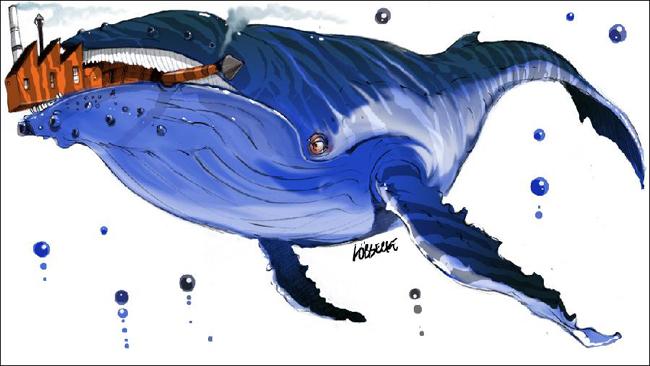
EARLY in the campaign to stop the Franklin Dam, Bob Brown and a friend with a 16mm camera kayaked along the Franklin River. Back in Hobart, they spliced together the best bits and distributed prints. In today's terminology, the pictures went viral.
"The television stations begged for it - they loved it," Brown told a triumphal wilderness conference in 1983, six months after the Franklin victory.
Send them a three-minute, well-labelled movie and "they'll use it time and time again".
The 30th anniversary of the Franklin campaign is an opportunity to assess the relative power of conservationists and industrialists and the state of play in the conflict between the wilderness industry - the anti-industrial industry if you like - and the industry that drives progress, productivity and prosperity.
Before the 1970s the scales were weighted in the developer's favour. The only environmental group that had a full-time executive was the Australian Conservation Foundation.
The hard slog of campaigning fell to the bushwalking fraternity, who were outwitted and outgunned at every turn.
Since Franklin, however, professional environmentalism has grown exponentially; the ACF competes for space with the Wilderness Society, Greenpeace, the Conservation Council, the World Wildlife Fund, and many other bodies with full-time secretariats and multi-million-dollar budgets.
They are the ambulance chasers of the biosphere, swarming around any new cause, such as BHP Billiton's latest plan to drill for oil near Ningaloo Reef.
Fighting causes is what they do for a quid, and without them they expire. The wilderness industry employs hundreds of workers who fight for customers in the expanding market for empathy.
Despite its dominance and the support from its friends in government, the wilderness industry still manages to persuade consumers that it is on the side of the little guys.
One of the quirks of modern capitalism is that the word "big" has become popularly pejorative; big mining, big tobacco, big pharma and big fishing trawlers are just a few of the victims of this unchecked size-ism that clouds the civic debate.
A common misconception is that large corporations alone have access to modern marketing and that they conspire with their friends in big media to manipulate public opinion.
It is nonsense, of course; corporations can be spectacularly bad at selling themselves, as opposed to selling their products, and often receive poor returns on their brand-advertising dollar.
The wilderness industry, by contrast, is a master of low-cost and no-cost advertising. The success of the anti-Franklin campaign owed much to the manipulated image; Brown installed a "camouflage cupboard" (his term) at the Wilderness Society headquarters where he kept a collection of second-hand suits, shirts, shoes and dresses for his spokespeople.
"It is importance to look conservative because that allows people to relate to our message, rather than see us as different, strange or threatening," he told campaigners.
"Appearance is never more important than when you have a TV camera aimed at you."
Like every successful manufacturer of compassion, the wilderness industry has learned that every good cause requires a victim with an unprotected plight. In the absence of the discovery of a nest of pandas sheltering in the Tamar Valley, the Gunns pulp mill protesters sought out the nearest available trophy victim, which happened to be a whale.
Whales are the walk-on, bit-part players of environmental dramas, suitable for almost every coastal conservation battle. Their success in this field has broken all the rules of victimology; vulnerable species do not have to be furry, as once believed, or necessarily endangered. Neither is the size of their eyes as crucial as once thought.
Cartological pedants may have noticed that the pulp mill was to be situated in the Tamar estuary, several kilometres from the sea. Nonetheless, Gunns agreed to deploy certified marine mammal officers during construction, equipped with range-finder binoculars and two-way radios. Should a whale be sighted within a 3km radius, construction of the $2.3 billion project would stop while the little fellow meandered past. Similar care would be taken for the welfare of fur seals, wedge-tailed eagles and the central north burrowing crayfish. Bubble curtains were to be erected to protect the Prototroctes maraena, or cucumber mullet to its friends.
It was to no avail since the wilderness industry - big wilderness as we should perhaps start calling it - was playing with Gunns in the same way a cat toys with a mouse.
No corporation is strong enough to compete with the might of big wilderness. Gunns was obliged to write down the $250 million it had invested in learning to jump through hoops and the company went into liquidation.
Three decades after Franklin, it is surely time to recognise that the environmental movement now effectively controls Australia's future. Unelected and unelectable, an eco-oligarchy sets the rules that governments and industrialists must follow.
The Franklin was the last noble battle in the war to save the wilderness, exempting large stretches of the Australian landmass from mankind's dominion. After Franklin, conservationists recognised that the hunt for new wilderness areas was over; the heavy lifting had been done to protect Kakadu, the north Queensland forests, the Great Barrier Reef and the Australian Alps; only fine detail remained.
Such is the environmental industry's appetite for fresh causes, however, that it has been forced to campaign beyond the boundaries of what was once considered wilderness.
Gunns' pulp mill was to have been built next door to an aluminium smelter. Environmentalists stopped the Traveston Dam from being built on the degraded Mary River catchment in southeast Queensland, out of concern for a turtle so common that it used to be sold in pet shops.
Now, with the banning of the super-trawler, it appears that the wilderness industry does not even need the backing of science. All it needs is backing of social media, an unaccountable and unrepresentative vehicle for the expression of public opinion.
At the wilderness conference in September 1983, when Brown shared the secrets of his camouflage cupboard, the ACF's vice-president Milo Dunphy took stock of victories, now long forgotten: the Coalcliff coal-loader, the Boyd Plateau pine plantations and the Colong Caves limestone mines. Dunphy told delegates: "We have demonstrated a right of veto over development." He wasn't kidding.



